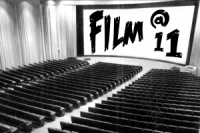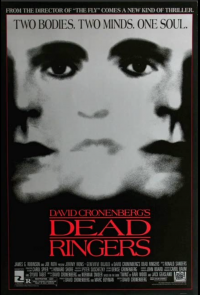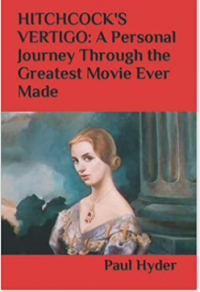




This week, Jeff Godsil revisits David Cronenberg's psychological thriller Dead Ringers, while in our book corner, we look at two brand new single volume examinations of Alfred Hitchcock's 1959 Vertigo, recently re-rated by Sight and Sound magazine as the second greatest film ever made.
–––––––––––––––––––––––––––––––––––––––––––––––––––––
Here's the text of the Vertigo review:
Vertigo books
The story behind Vertigo is probably well known to most film students. Based on a French thriller, Alfred Hitchcock filmed it in 1957 and Paramount released it in 1958. The reviewers mostly deemed it slow and implausible, and the film made only $3.2 million from a $2.5 million dollar budget, though the film also made money internationally. Eventually Hitchcock came to own the rights to this and several other Paramount films and withdrew them and Vertigo. The films aired sometime in the mid sixties on network television and that was the first time that many budding cinephiles had a chance to see the key works from his strong ’50s period. Hitchcock recovered from the “failure” of Vertigo with North by Northwest, and then Psycho, through which he became a millionaire. The package of films finally found re-release to the screens in the 1982, and that may have been a zero day event, that and a so-called “restored” Vertigo in 1995, that saw Vertigo crawl slowly up the Sight and Sound greatest films list, until it reached No. 1 in 2012, reputedly with the lobbying of writer David Thomson. The decadal poll saw the film’s dethronement to no. 2 in favor of Jeanne Dielmann ….
Since 1965 when Robin Wood “defended” the film in his exemplar Hitchcock’s Films, there have been some several hundred books on Hitchcock five of them just on Vertigo. Now there are two more single volumes. They are:
Vertigo, Haunted by Vertigo: Hitchcock's Masterpiece Then and Now, edited by Hitchcock expert Sydney Gottlieb and Donal Martin, a collection of 11 essays, published by the John Libby Publishing Company.
And:
Hitchcock’s Vertigo: A Personal Journey Through the Greatest Movie Ever Made, written by and self-published by Paul Hyder.
We’ll discuss that one first.
Mr. Hyder’s A Personal Journey is a heartfelt examination of what happens in the film, scene by scene. Much of the book is long passages of dialogue and accounts of music cues and visual elements. The prose has an “amateur” feeling, in that the author doesn’t come off like an academic with a jargon that serves as a shorthand to other experts, and there is what now feels like an old-fashioned use of “symbols” such as Coit Tower representing phallic energy, an a reliance on the out of date mantras of psychoanalysis as a way of interpreting events that don’t really need further explaining. On the other hand, Mr. Hyder comes up with several new and interesting associations:
- The influence of The Portrait of Dorian Gray.
- The adaptation of Romantic painters such as Caspar David Friedrich and Karl Friedrich Lessing, and even the Pieta as visual inspirations.
- Hitchcock’s use of standing architecture and monuments to underscore moods and emotions.
And he makes the interesting point that though there is a lot of passion in the film, there is little in the way of real love. Vertigo has darker obsessions.
Here’s an example of the style:
Carlotta
A few errors creep in. Page 76 has “Henry James” for the character actor Henry Jones at the inquest, for example. And thought Stewart’s character behaves as if in a dream-like or twilight state of mind, generally I reject interpretations of a narrative or a movie as “the whole thing’s a dream,” (xxxx, Belle du jour) unless there is internal evidence of some kind.
Nevertheless Mr. Hyder’s book is a welcome addition to studies of Vertigo, and so is Haunted by Vertigo. Just when you conclude that all that can be said about the film has reached its limit, then along comes this anthology of 11 new essays on all aspects of the film. Editor Sidney Gottlieb is a Communications professor and edits the Hitchcock Annual, as well as three collections of interviews with and writings credited to Hitchcock. Donal Martin has organized conferences on Vertigo in Ireland, and made a film about the film for its 60th anniversary.
Other contributors include Charles Bar, Janet Bergstrom, Robert Belton and Laura Mulvey among others, all authorities on Hitchcock. The subjects include the visual influence of F. W. Murnau on Hitchcock and Vertigo, French influences on the film, a comparison of Vertigo with Nabokov’s Lolita, Scottie Ferguson’s hospitality, various objects in the film and their hidden meanings, various San Francisco monuments incorporated into the film, the orchestration of looks and gazing in the narrative and visuals, and automata in commercial cinema and Vertigo.
A representative essay is Janet Bergstrom’s “Hitchcock After Murnau: The Influence of Perspectival Shooting in Vertigo,” the second essay in the book.
This piece breaks down thus:
- Hitchcock’s professional fascination with Murnau, director of Nosferatu and The Last Laugh, which Hitchcock observed shooting in Berlin at the time.
- Murnau’s use of forced perspective on that film, for street scenes outside the story’s hotel location.
- The cost and collaboration of using forced perspective, suggesting how important the look was to the director, as certain visual effects were to be for Hitchcock as well.
- An examination of two shots from Vertigo, using the technique and what the shots mean.
- Here are some samples from the text:
… the possibilities of perspectival shooting never left Hitchcock’s repertoire. Consider two shots from Vertigo, special shots requiring special treatment: the “vertigo shot” and the “bell tower shot”.
According to art director Henry Bumstead, “In every picture Hitch had one thing that he was really adamant about, and [in Vertigo] that was the opening of the picture where they’re running across rooftops” leading to the shot that establishes Scottie’s vertigo.
Bumstead printed “forced perspective”after the typed caption for the story board sketch that shows Scottie’s point of view as he looks down, trying to hang on to a rain gutter after slipping on the wet roof, and watches a policeman fall to his death
Bumstead continues:
“That sets up the whole picture, that vertigo ... Then I realized that I had to do a forced perspective. It got the effect that Hitch wanted, and he was very pleased with it. But you had to put the camera in exactly the spot this stuff was figured out for, otherwise it didn’t work.” Bill Taylor, director of photography and contemporary visual effects supervisor, added: “In terms of the matte painting, the tone and color-matching is achieved over a period of successive tests that come back from the lab every day. It’s sort of an evolutionary process that can take weeks or even months.”
The “vertigo shot” is the first of the corresponding pair of forced perspective shots in Vertigo. Scottie’s vertigo will damage him psychologically and limit him physically so that he can be used to propel the story forward. But the shot does not necessarily call attention to itself as “false” or “forced” because it is part of a tense, fast-cut chase across rooftops, ending in Scottie almost falling to his death, motivating his terror of heights.
The reply to that shot is one of Hitchcock’s signature visuals that calls attention to itself so strongly that it almost risks taking the spectator
out of the narrative. It is the high overhead shot of the bell tower at the Mission, where Scottie drives Madeleine
The tower was created with a matte (the Mission doesn’t have a tower) rendered in strongly forced perspective, its huge white mass taking up the middle of the image, its lines becoming wider and wider as it goes out of frame at the top, angled toward the audience, its sudden prominence unmotivated by the story.
Why did Hitchcock want such a noticeable shot at this point in the story? One could speculate that the bell tower functions as an objective correlative (an unavoidable object) that triggers in Scottie an even more deadly return of his vertigo that goes far beyond its initial consequences. The bell tower is the mechanism for the false Madeleine’s false death which we (and then Scottie) only learn later. As Scottie unsteadily retreats down the stairs that he has managed to climb, he believes that Madeleine is dead and he knows that his vertigo, the uncontrollable point of his psyche, prevented him from running up the rest of the stairs to the top to save her. The false truth of Madeleine’s death leads to the second part of the film, to Scottie’s inner death: the loss of his self-worth, his sense of self, his heart. Now a complementary weakness in his psyche will play itself out in his obsession with bringing Madeleine back to life by remaking Judy in her exact image.Whence his reversal to the most bitter anger when he realizes that she is the same woman, that Madeleine’s death had been faked, and that he had been used, even the intimacy of falling in love with her.
Finally, though, even with its symmetrical emotional resonance, the “meaning” of the bell tower shot is irreducible to explanation: its beauty conspires with its audacity. But then, Hitchcock loved to thwart the logical progression of meaning, probably just as much as he delighted in recounting (as if reliving) the necessary progression across visuals and sound in his scenes.
Doubtless Murnau would have agreed with Hitchcock about masking meaning when it was important to his overall design to do so. Both found many uses and techniques for more or less exaggerated (or noticeable) forced perspective, working against redundancy, eliminating “unnecessary” narrative explanations. Their imaginative control concentrated on building the integrity of the entire composition as such.
Neither Hitchcock nor Murnau would give explicit meanings for the special effects in their films, so important to them, so costly and difficult to execute, including, but of course not limited to, forced perspective. The more carefully the film viewer looks, the more shots with forced perspective can be detected, but that is not the same as saying that the meaning of its use is reducible to explanation. That is part of the emotional beauty of the special shots in Vertigo.”
This piece like all the others is amply illustrated. And that’s just one essay. All the others also have new and unexpected observations to make. I can’t imagine any new perspectives awaiting us about Vertigo – but that’s what I said before starting these two excellent volumes.
Start
Contents
Start
Front Matter
Notes on Contributors
Introduction Sidney Gottlieb
Acknowledgments
1 Reading Alfred Hitchcock’s Vertigo Through the Myth of Io and Argos Mark W. Padilla
2 Hitchcock After Murnau: The Influence of Perspectival Shooting in Vertigo Janet Bergstrom
3 Versions of Vertigo: They Wake Up Screaming Mark Osteen
4 Hitchcock and Vertigo: French and Other Connections Charles Barr
5 Fatal Resemblances: Cross-mapping Hitchcock’s Vertigo with Nabokov’s Lolita Barbara Straumann
6 The Sounds and Sights of Vertigo’s Afterlife in Art Christine Sprengler Chamber Made Opera’s Phobia (2003) and Jean Curran’s The Vertigo Project (2018)
7 Incidental Meaning and “Hidden Hitchcock” in Vertigo Robert Belton
8 The Hospitality of Scottie Ferguson Ned Schantz
9 Hitchcock and the Tourist Gaze: Vertigo and the Monuments of San Francisco Steven Jacobs
10 The Variety of Gazes in Vertigo Sidney Gottlieb
11 The Metaphor of the Beautiful Automaton Reanimated: Artifice, Illusion, and Late Style in Vertigo Laura Mulvey
Index
- KBOO


